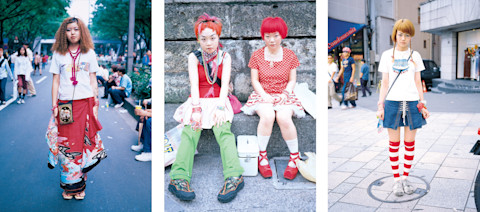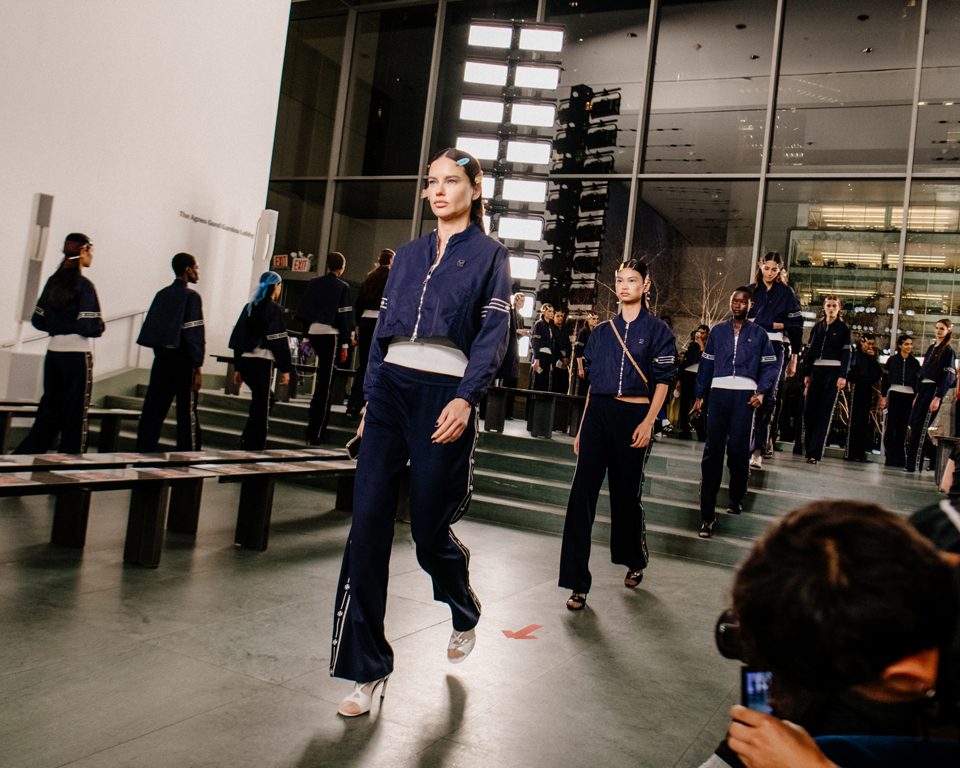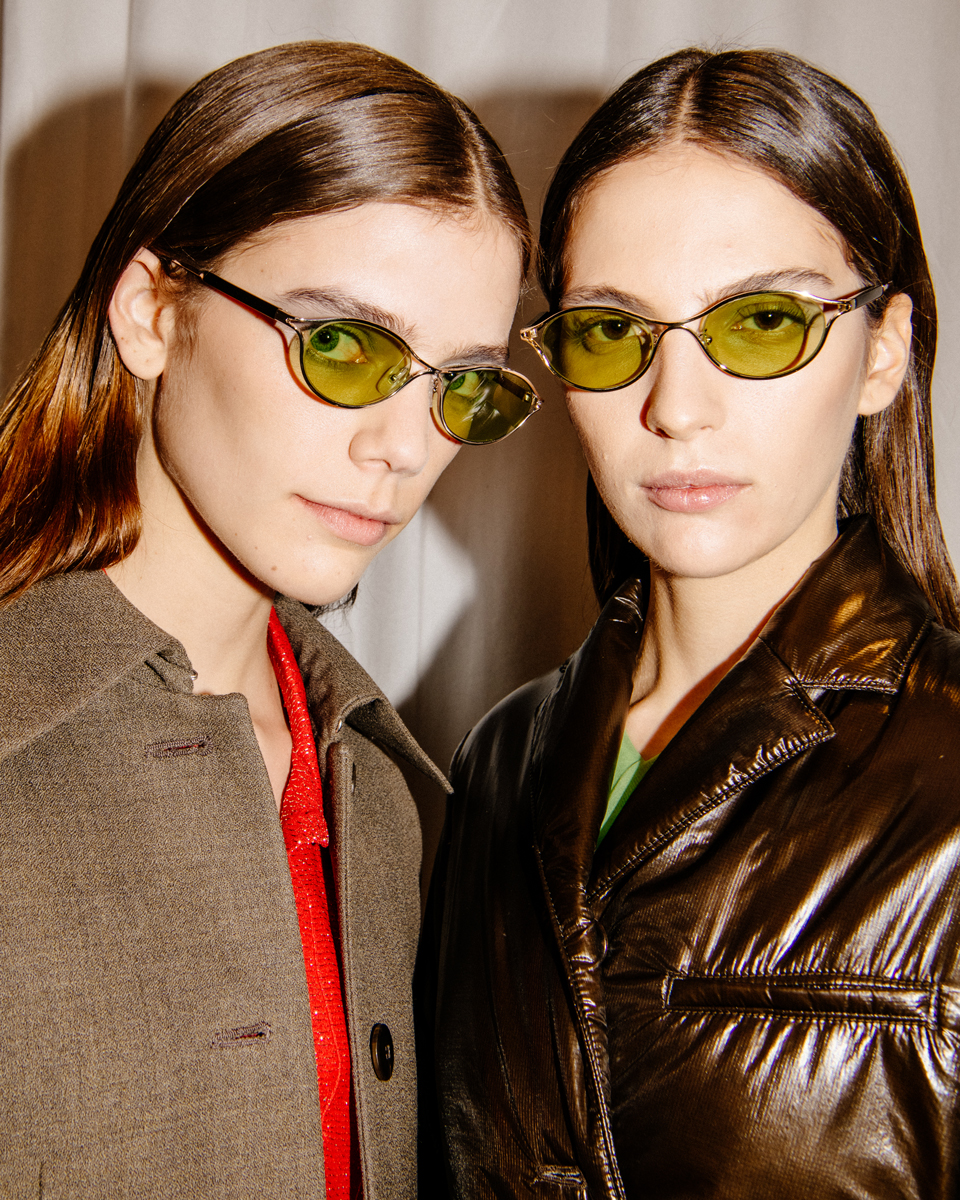The Most Iconic Harajuku Street Style Shots of All Time
FRUiTS magazine founder and photographer Shoichi Aoki looks back on Harajuku’s golden era and its revival in the digital age.

Tokyo’s famed Harajuku neighborhood is crowded with tourists, a mix of languages contributing to the noise, forcing you to weave through the throngs just to move forward. Amidst the chaos, a man with gray hair drifts through the streets with an iPhone in hand, searching for a subject. It’s Shoichi Aoki, a street photography pioneer who has been documenting the styles of Paris and London since the ’80s. “There are still some stylish kids,” he says of the bustle today, “but they get drowned out by the tourists.”
For years, Harajuku was a sacred ground for street fashion. Since the late ’90s, FRUiTS magazine, which Aoki founded, chronicled the scene—bold, eccentric, and unique. While those once-iconic silhouettes may not be as present now, the aesthetics born here have rippled outward, influencing the world’s most renowned designers. “I’d love to bring FRUiTS back,” Aoki muses. In the early ’80s, Aoki embarked on a solo trip across Europe. In Paris, he was struck by the effortless creativity of young women’s fashion—sophisticated, expressive, and unlike anything he’d seen before. He hadn’t set out to become a photographer, but his fascination with street style took hold. Determined to bring the energy of Paris back home, Aoki launched his first of four magazines, STREET, in 1985, which captured the pulse of the city’s underground style.

Then came Harajuku, a longtime hub for bold, youth-driven fashion. Emerging as a countercultural response to Japan’s DC fashion boom (homegrown Japanese fashion labels are known collectively as DC, an abbreviation for Designer & Character), the district cultivated an aesthetic entirely its own. Aoki was there, camera in hand. In 1997, he founded FRUiTS, dedicated solely to the fearless, unfiltered looks of Harajuku’s youth. Around the same time, figures like Hiroshi Fujiwara and NIGO were fueling the rise of Ura-Harajuku’s menswear movement.With its radical use of color and unconventional styling, FRUiTS became more than a magazine—it was a cultural archive. The images traveled far beyond Japan, catching the attention of designers worldwide. But by the late 2000s, fast fashion’s dominance pushed independent Harajuku brands into a corner. “There just weren’t enough stylish kids left to shoot,” Aoki recalls. FRUiTS published its final issue in 2017.News of its hiatus left fashion fans around the world heartbroken, with global outlets like BBC and CNN rushing to cover the story. Following a brief break, Aoki is not only reviving the magazine, but collaborating with brands such as Vivienne Westwood, PALACE, and BEAMS, proving through his lens that youth and street fashion remain as strong as ever. Aoki, now 70, spoke about Harajuku’s golden era, the present, and his upcoming plans.

You had been documenting street fashion abroad. What made you decide to launch FRUiTS?What emotions or cultural shifts did Harajuku’s style reflect?Harajuku fashion feels so free of rules—did any exist?
Around the time Comme des Garçons and Yohji Yamamoto started losing their dominance, something interesting was happening in Harajuku. The district had always been a fashion hub, but suddenly a new style was emerging, something completely different from what I had seen in Paris or London. And the quality wasn’t bad, either. I had a feeling it was the beginning of something big, so I started shooting. After about six months of photographing these kids, I decided to turn it into a magazine. That’s how FRUiTS was born.It was, in part, a reaction against the dominance of dark, minimalist DC fashion. Young people were looking for something fresh. Around that time, a lot of hairstylists from Harajuku started training in London, bringing back not just vibrant hair dyes but an entire cultural sensibility—fashion, attitude, everything. Brands like Vivienne Westwood, with its rebellious use of color, and Christopher Nemeth made their way into the mix. You could see those influences all over the scene.At first, there was a clear Vivienne Westwood influence in nearly everyone’s style. Then brands like 20471120 and BEAUTY:BEAST came in from Osaka, and people started curating their looks around them. But after a few months, the idea of wearing head-to-toe branded outfits started feeling uncool. Mixing became the new standard—pairing high-end pieces with thrifted finds, layering expensive and cheap in ways that made no logical sense but somehow looked incredible. Students from design schools like Bunka, Vantan, and Nichibi were leading the charge, shaping the Harajuku aesthetic in real time.
Where did these kids get their fashion inspiration?What kinds of subcultures were popular at the time? And what were you into?What was the atmosphere like in Harajuku during its peak?
This was a time before the internet, so they absorbed an enormous amount of visual information wherever they could find it. There weren’t many brands yet, so they had no choice but to invent their own ways of dressing. After FRUiTS launched, the magazine itself became a catalyst. The more people saw it, the more they realized just how cool the scene was. Eventually, charismatic shop staff started to emerge, shaping and influencing the style of younger kids.Honestly, the idea of “subcultures” didn’t really exist then—I was only interested in fashion. Music was the only other major movement. I guess Namie Amuro had a real influence on personal style, but that was about it. Anime was something happening in Akihabara, completely separate from fashion. If anything, anime was taking inspiration from Harajuku fashion, not the other way around. It’s the opposite of today, where people borrow looks straight from anime.It was an intimidating place—if you weren’t dressed up, you didn’t belong. Ordinary people probably felt out of place. The whole district was packed with kids who just wanted to push their style further. Back then, Harajuku was the only real street snap scene in Tokyo, but I’d heard rumors about Osaka’s underground fashion culture. That led me to Triangle Park, where I started shooting as well. There was no direct exchange of trends between Tokyo and Osaka at the time—each city developed its own style independently. Osaka was all about maximalism, adding more and more elements to stand out. Tokyo, on the other hand, was about refinement, stripping things back to make them feel sophisticated.

What does street fashion mean to you?How did the world react to Harajuku fashion in the early days?Did you start noticing Harajuku fashion influencing people in Paris and London?The influence of Ura-Harajuku [Harajuku backstreets] fashion is still visible in today’s luxury streetwear boom. Do you see this as a continuation of the original movement?
It’s a form of self-expression. A way of saying, “This is how I decided to wear it—what do you think?” It’s a message from the person wearing the clothes. When I shot Akichan [Aki Kobayashi] for the first FRUiTS cover, I asked if I could take their photo. They just stood there—no change in expression, no pose. They asked, “What should I do?” and I told them, “Just stay as you are.” That moment set the tone for FRUiTS. From then on, none of the subjects posed or changed their expressions—it became the signature style of the magazine. To me, street snaps are documentaries. I don’t need model-like posing. It’s like collecting specimens—if the subject just spreads their wings naturally, that’s enough.Five years after launching FRUiTS, a UK publisher released two photobooks featuring our street snaps. They sold about 200,000 copies, drawing global attention. Before that, the prevailing image of Japanese fashion abroad was uniformed salarymen and school students. Seeing these highly individualistic styles surprised the foreign press, prompting them to come and document the scene. Kinokuniya’s overseas stores also stocked FRUiTS, which helped it gain international recognition.At some point, we began to see entire looks inspired by Harajuku abroad. Fashion Tsushin [Japanese fashion TV channel] even featured the global popularity of the Harajuku style. Karl Lagerfeld and other Paris collection designers started incorporating elements from it as design references. Western designers found it fascinating because it followed a completely different fashion logic from their own.Yes, in a way. Luxury brands eventually found themselves running out of new ideas, so they turned to street culture as a counter-fashion movement. Originally, streetwear wasn’t something for the wealthy, but it was rebranded into a luxury concept. When we launched TUNE in 2004, the Ura-Harajuku boom was already fading. Brands like A BATHING APE were struggling, and soon after, NIGO sold the brand. But more than just fashion, Ura-Harajuku introduced a new business approach—stylist-turned-entrepreneurs like Hiroshi Fujiwara and NIGO mixed high-fashion with streetwear, created limited-edition drops, and built hype through scarcity. Over a decade later, their close friend Kim Jones began merging streetwear with luxury at Dior. That’s when the luxury streetwear movement really took off.

As someone who pioneered Harajuku street fashion, how do you feel about this shift?Why did FRUiTS cease publication?What were your feelings when you decided to stop?What has FRUiTS been up to since?
By the early 2010s, fast fashion dominated the market—H&M and Forever 21 were everywhere. Independent designers struggled to survive. Then Virgil Abloh and Demna Gvasalia emerged, bringing a fresh perspective and reviving the fashion industry just as it was on the brink of collapse.We had to publish FRUiTS every month, but stylish people had disappeared from the streets. With the rise of fast fashion, Harajuku’s creativity was eroded, leaving us with nothing but uninspiring looks. The people walking around just looked . . . normal. If we had to start publishing photos we weren’t satisfied with, then there was no point. The only choice was to stop.I didn’t want anyone to notice. I hated hearing “You’re quitting?” so I wanted to end it quietly. We slipped a small notice into the final issue saying, “This will be the last one.” But someone at fashionsnap.com caught it, and suddenly the news spread worldwide—BBC and CNN wanted to cover it and Opening Ceremony reached out for a collaboration. That’s when I realized how many people had been reading FRUiTS.During the pandemic, I had time to scan and digitize STREET. We digitized up to the hundredth issue and started selling them—it turned out to be a huge success. Honestly, I think almost everyone working in luxury fashion abroad owns a digital archive. Aside from that, I take on photography projects when I receive offers.

What makes print special?There’s a sense of care in physically keeping magazines?What’s next for FRUiTS?
Print is tough: It takes time, money, and effort. You shoot on film, scan it, edit it on a monitor, then print it. People look at the final magazine and say, “This is great,” but for me, the original film is the best version. The entire printing process just feels like a downgrade. But FRUiTS became legendary precisely because it was a print magazine—if it had been a digital platform, it wouldn’t have had the same impact.Absolutely. Once it’s digital, that sense of ownership disappears. I’ve kept all 670 issues of STREET, FRUiTS, and TUNE. FRUiTS isn’t fully digitized yet, so I need to work on that.Since we stopped, we haven’t published a single new issue. But I have hundreds of unpublished photos that I’ve taken over the years, so I’m considering compiling them into a book. I also want to make a photo book from our archives. The 2000s and early 2010s were particularly strong years—several kids became iconic because of FRUiTS. The creativity was on another level. It’s clear now: I have to bring FRUiTS back.

 Fall/Winter 2025: The Warmup The Tory Sport tracksuit is a brand tradition – a comfortable and chic coordinated set for models to wear backstage before the show. This season it was in navy – a cropped nylon bomber and slouchy twill pants – trimmed with embroidered logo tape. One new twist: in place of sneakers, models wore the new Reva ballet, a reinvention of our iconic ballet flat reintroduced on the spring runway. Luckily, the refined design doesn’t sacrifice comfort with a hidden sliver wedge and a sleek beveled medallion that molds perfectly to the foot.
Fall/Winter 2025: The Warmup The Tory Sport tracksuit is a brand tradition – a comfortable and chic coordinated set for models to wear backstage before the show. This season it was in navy – a cropped nylon bomber and slouchy twill pants – trimmed with embroidered logo tape. One new twist: in place of sneakers, models wore the new Reva ballet, a reinvention of our iconic ballet flat reintroduced on the spring runway. Luckily, the refined design doesn’t sacrifice comfort with a hidden sliver wedge and a sleek beveled medallion that molds perfectly to the foot. 
